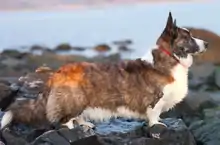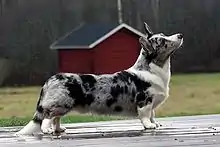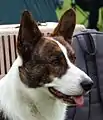Cardigan Welsh Corgi
The Cardigan Welsh Corgi /ˈkɔːrɡi/ is one of two separate dog breeds known as Welsh Corgis that originated in Wales; the other is the Pembroke Welsh Corgi. It is one of the oldest breeds of the British Isles.[1]
| Cardigan Welsh Corgi | |||||||||||||
|---|---|---|---|---|---|---|---|---|---|---|---|---|---|
 Brindle and white Cardigan Welsh Corgi | |||||||||||||
| Common nicknames | Cardigan CWC Cardi | ||||||||||||
| Origin | Wales | ||||||||||||
| |||||||||||||
| Dog (domestic dog) | |||||||||||||
Cardigan Welsh Corgis are known to be an extremely loyal dog breed.[2] They are also versatile and can live in a variety of settings. They benefit from regular physical and mental stimulation.
History
Pembroke and Cardigan Welsh Corgis were originally listed as one breed by The Kennel Club in Britain in 1925, but were declared separate breeds in 1935.[3] The Corgi Club was founded in December 1925 in Carmarthen in South Wales.[4] It is reported that the local members favored the Pembroke breed, so a club for Cardigan enthusiasts was founded a year later (1926).[4] Both groups have worked hard to ensure the appearance and type of breed are standardized through careful selective breeding.[4] Pembrokes and Cardigans were officially recognized by the Kennel Club in 1928 and were lumped together under the heading Welsh Corgis.[4] In 1934, the two breeds were recognized individually and shown separately.
Origins

One theory is that both breeds of the corgis descended from a line of northern spitz-type dogs.[5] Another is that they descended from the Teckel family of dogs, which also produced Dachshunds.[6]
Name
The word "corgi" is derived from the Welsh: cor gi, which means "dwarf dog".[7] The breed was formerly called "yard-long dog" (Welsh: ci-llathed).[8] Today's name comes from their area of origin: Cardigan (Welsh 'Ceredigion').
Modern breed
Originally used only as a farm guardian, they eventually took on the traits of a cattle drover, herder, and many more.[9] They are still highly valued for their herding, working, and guarding skills, as well as their companionship.
Description
The Cardigan is a long, low dog with upright ears and a fox brush tail.[10] The old American Kennel Club standard called it an "Alsatian on short legs". The Cardigan's tail is long (unlike the Pembroke Welsh Corgi, whose tail may be long,[11] naturally bobbed or docked[12]).
Cardigans, which are double coated, come in a variety of colors including any shade of red, sable, or brindle, as well as black, with or without tan, brindle or blue merle, with or without tan or brindle points. Other unofficial colors can occur, such as red merle, but these colors are not considered acceptable per the Cardigan standard. They usually have white on the neck, chest, legs, muzzle, underneath, tip of the tail and as a blaze on the head, known as the "Irish pattern." Other markings include ticking on the legs and muzzle, smutty muzzles and monk's hoods, especially on sables (a pattern of darker tipped hairs over a basic red coat color.). An average Cardigan is around 10 to 13 inches (250 to 330 mm) tall at the withers and weighs from 30 to 38 pounds (14 to 17 kg) for the male and 25 to 34 pounds (11 to 15 kg) for the female.[13]
Life expectancy is 12–16 years.[14] Litter size can vary; usually four to six puppies.
Health
The most common causes of death for the breed were cancer (28.3%), old age (24.6%), and neurological disorders (15.2%).[15][16]
Canine Intervertebral Disc Disease (IVDD) is known to occur in the Cardigan Welsh Corgi. This is likely due to the Cardigan being a dwarf (chondrodysplastic) breed, and these breeds frequently suffer from Type I disk disease. This disease is commonly found in the Dachshund breed.[17]
Temperament
- Originally bred for farm work, including herding sheep and cattle. Cardigan Welsh Corgis were bred long and low to make sure that any kicks by cattle would travel safely over the dogs' heads without touching them.
- Cardigans are highly intelligent, active, athletic dogs.
- Housepet They have proven themselves as excellent companion animals, Cardigans are affectionate, devoted companions that can also be alert and responsible guardians. If socialized at a young age, they can be nice with other dogs and housepets.
- Competitive in sheepdog trials, dog agility, competitive obedience and rally obedience.
- Guard Dogs They are great watch dogs, but if it's a guard dog it will do not as well as the better choices.
Use as working dogs
Cardigan Welsh Corgis compete in dog agility trials, obedience, showmanship, flyball and tracking events. Herding instincts and trainability can be measured at noncompetitive herding tests. Corgis exhibiting basic herding instincts can be trained to compete in herding trials.[18]
References
- "Cardigan Welsh Corgi - Details". American Kennel Club. Retrieved 1 March 2017.
- Sheldon L. Gerstenfeld; Jacque Lynn Schultz; American Society for the Prevention of Cruelty to Animals (15 October 1999). ASPCA complete guide to dogs. Chronicle Books. pp. 160–. ISBN 978-0-8118-1904-6. Retrieved 11 December 2011.
- "Corgis and the Queen: Celebrating the breed that the Queen made popular". www.thekennelclub.org.uk. Retrieved 2019-01-04.
- Debra M. Eldredge (27 January 2009). Pembroke Welsh Corgi: Your Happy Healthy Pet, with DVD. John Wiley and Sons. pp. 21–. ISBN 978-0-470-39061-0. Retrieved 10 December 2011.
- Debra M. Eldredge (27 January 2009). Pembroke Welsh Corgi: Your Happy Healthy Pet, with DVD. John Wiley and Sons. pp. 21–. ISBN 978-0-470-39061-0. Retrieved 10 December 2011.
- "History of the Cardigan Welsh Corgi". Cardigan Welsh Corgi Association. Archived from the original on 2007-04-29.
- "Corgi". Dictionary.com. Retrieved 2018-01-02.
- "The "Yard-Long" Dog". National Purebred Dog Day. 2017-09-09. Retrieved 2018-01-02.
- Jan Greye; Gail Jesse Smith (30 July 2002). Puppy Parenting: Everything You Need to Know About Your Puppy's First Year. HarperCollins. pp. 30–. ISBN 978-0-06-001260-1. Retrieved 11 December 2011.
- Richard G. Beauchamp (1 March 2010). Welsh Corgis: Pembroke and Cardigan. Barron's Educational Series. pp. 25–. ISBN 978-0-7641-4242-0. Retrieved 11 December 2011.
- Hytönen et al. (2008), "Ancestral T-box mutation is present in many, but not all, short-tailed dog breeds", Journal of Heredity, Advance Access published online on October 14, 2008, doi:10.1093/jhered/esn085
- "Pembroke Welsh Corgi Breed Standard". American Kennel Club.
- "Welsh Corgi Cardigan Dog Breed - Facts and Traits | Hill's Pet". Hill's Pet Nutrition. Retrieved 2019-01-04.
- Eve Adamson; Richard G. Beauchamp; Margaret H. Bonham; Stanley Coren; Miriam Fields-Babineau (29 March 2010). Dogs All-In-One for Dummies. John Wiley & Sons. p. 535. ISBN 978-0-470-52978-2. Retrieved 11 December 2011.
- "2004 Purebred Dog Health Survey". The Kennel Club. Retrieved 16 August 2010.
- "2017 Dog Insurance Survey". Top10 Pet Insurance. Retrieved 11 May 2017.
- "Health: IVDD – Cardigan Welsh Corgi Club of America". Retrieved 2020-02-10.
- Hartnagle-Taylor, Jeanne Joy; Taylor, Ty (2010). Stockdog Savvy. Alpine Publications. ISBN 978-1-57779-106-5.
External links
| Wikimedia Commons has media related to Welsh Corgi Cardigan. |
- MyCorgi.com (non-profit charity & social networking for corgi owners)








